+ Open data
Open data
- Basic information
Basic information
| Entry | Database: PDB / ID: 7nj1 | |||||||||
|---|---|---|---|---|---|---|---|---|---|---|
| Title | CryoEM structure of the human Separase-Securin complex | |||||||||
 Components Components |
| |||||||||
 Keywords Keywords |  HYDROLASE / pseudosubstrate HEAT repeat caspase cell cycle HYDROLASE / pseudosubstrate HEAT repeat caspase cell cycle | |||||||||
| Function / homology |  Function and homology information Function and homology informationnegative regulation of mitotic sister chromatid separation / negative regulation of sister chromatid cohesion /  separase / meiotic chromosome separation / establishment of mitotic spindle localization / homologous chromosome segregation / meiotic spindle organization / positive regulation of mitotic metaphase/anaphase transition / cysteine-type endopeptidase inhibitor activity / mitotic sister chromatid segregation ...negative regulation of mitotic sister chromatid separation / negative regulation of sister chromatid cohesion / separase / meiotic chromosome separation / establishment of mitotic spindle localization / homologous chromosome segregation / meiotic spindle organization / positive regulation of mitotic metaphase/anaphase transition / cysteine-type endopeptidase inhibitor activity / mitotic sister chromatid segregation ...negative regulation of mitotic sister chromatid separation / negative regulation of sister chromatid cohesion /  separase / meiotic chromosome separation / establishment of mitotic spindle localization / homologous chromosome segregation / meiotic spindle organization / positive regulation of mitotic metaphase/anaphase transition / cysteine-type endopeptidase inhibitor activity / mitotic sister chromatid segregation / mitotic cytokinesis / chromosome organization / cysteine-type peptidase activity / separase / meiotic chromosome separation / establishment of mitotic spindle localization / homologous chromosome segregation / meiotic spindle organization / positive regulation of mitotic metaphase/anaphase transition / cysteine-type endopeptidase inhibitor activity / mitotic sister chromatid segregation / mitotic cytokinesis / chromosome organization / cysteine-type peptidase activity /  catalytic activity / APC/C:Cdc20 mediated degradation of Securin / molecular function activator activity / APC/C:Cdh1 mediated degradation of Cdc20 and other APC/C:Cdh1 targeted proteins in late mitosis/early G1 / catalytic activity / APC/C:Cdc20 mediated degradation of Securin / molecular function activator activity / APC/C:Cdh1 mediated degradation of Cdc20 and other APC/C:Cdh1 targeted proteins in late mitosis/early G1 /  mitotic spindle / mitotic spindle /  SH3 domain binding / Separation of Sister Chromatids / SH3 domain binding / Separation of Sister Chromatids /  spermatogenesis / spermatogenesis /  cell division / cysteine-type endopeptidase activity / cell division / cysteine-type endopeptidase activity /  DNA repair / DNA repair /  centrosome / apoptotic process / centrosome / apoptotic process /  proteolysis / proteolysis /  nucleus / nucleus /  cytosol / cytosol /  cytoplasm cytoplasmSimilarity search - Function | |||||||||
| Biological species |   Homo sapiens (human) Homo sapiens (human) | |||||||||
| Method |  ELECTRON MICROSCOPY / ELECTRON MICROSCOPY /  single particle reconstruction / single particle reconstruction /  cryo EM / Resolution: 2.9 Å cryo EM / Resolution: 2.9 Å | |||||||||
 Authors Authors | Yu, J. / Raia, P. / Ghent, C.M. / Raisch, T. / Sadian, Y. / Barford, D. / Raunser, S. / Morgan, D.O. / Boland, A. | |||||||||
| Funding support |  Switzerland, Switzerland,  United States, 2items United States, 2items
| |||||||||
 Citation Citation |  Journal: Nature / Year: 2021 Journal: Nature / Year: 2021Title: Structural basis of human separase regulation by securin and CDK1-cyclin B1. Authors: Jun Yu / Pierre Raia / Chloe M Ghent / Tobias Raisch / Yashar Sadian / Simone Cavadini / Pramod M Sabale / David Barford / Stefan Raunser / David O Morgan / Andreas Boland /     Abstract: In early mitosis, the duplicated chromosomes are held together by the ring-shaped cohesin complex. Separation of chromosomes during anaphase is triggered by separase-a large cysteine endopeptidase ...In early mitosis, the duplicated chromosomes are held together by the ring-shaped cohesin complex. Separation of chromosomes during anaphase is triggered by separase-a large cysteine endopeptidase that cleaves the cohesin subunit SCC1 (also known as RAD21). Separase is activated by degradation of its inhibitors, securin and cyclin B, but the molecular mechanisms of separase regulation are not clear. Here we used cryogenic electron microscopy to determine the structures of human separase in complex with either securin or CDK1-cyclin B1-CKS1. In both complexes, separase is inhibited by pseudosubstrate motifs that block substrate binding at the catalytic site and at nearby docking sites. As in Caenorhabditis elegans and yeast, human securin contains its own pseudosubstrate motifs. By contrast, CDK1-cyclin B1 inhibits separase by deploying pseudosubstrate motifs from intrinsically disordered loops in separase itself. One autoinhibitory loop is oriented by CDK1-cyclin B1 to block the catalytic sites of both separase and CDK1. Another autoinhibitory loop blocks substrate docking in a cleft adjacent to the separase catalytic site. A third separase loop contains a phosphoserine that promotes complex assembly by binding to a conserved phosphate-binding pocket in cyclin B1. Our study reveals the diverse array of mechanisms by which securin and CDK1-cyclin B1 bind and inhibit separase, providing the molecular basis for the robust control of chromosome segregation. | |||||||||
| History |
|
- Structure visualization
Structure visualization
| Movie |
 Movie viewer Movie viewer |
|---|---|
| Structure viewer | Molecule:  Molmil Molmil Jmol/JSmol Jmol/JSmol |
- Downloads & links
Downloads & links
- Download
Download
| PDBx/mmCIF format |  7nj1.cif.gz 7nj1.cif.gz | 272.1 KB | Display |  PDBx/mmCIF format PDBx/mmCIF format |
|---|---|---|---|---|
| PDB format |  pdb7nj1.ent.gz pdb7nj1.ent.gz | 210.8 KB | Display |  PDB format PDB format |
| PDBx/mmJSON format |  7nj1.json.gz 7nj1.json.gz | Tree view |  PDBx/mmJSON format PDBx/mmJSON format | |
| Others |  Other downloads Other downloads |
-Validation report
| Arichive directory |  https://data.pdbj.org/pub/pdb/validation_reports/nj/7nj1 https://data.pdbj.org/pub/pdb/validation_reports/nj/7nj1 ftp://data.pdbj.org/pub/pdb/validation_reports/nj/7nj1 ftp://data.pdbj.org/pub/pdb/validation_reports/nj/7nj1 | HTTPS FTP |
|---|
-Related structure data
| Related structure data |  12369MC  7nj0C M: map data used to model this data C: citing same article ( |
|---|---|
| Similar structure data |
- Links
Links
- Assembly
Assembly
| Deposited unit | 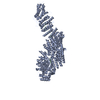
|
|---|---|
| 1 |
|
- Components
Components
| #1: Protein | Mass: 237610.469 Da / Num. of mol.: 1 Source method: isolated from a genetically manipulated source Source: (gene. exp.)   Homo sapiens (human) / Gene: ESPL1, ESP1, KIAA0165 / Production host: Homo sapiens (human) / Gene: ESPL1, ESP1, KIAA0165 / Production host:   Spodoptera frugiperda (fall armyworm) / References: UniProt: Q14674, Spodoptera frugiperda (fall armyworm) / References: UniProt: Q14674,  separase separase |
|---|---|
| #2: Protein | Mass: 22052.340 Da / Num. of mol.: 1 Source method: isolated from a genetically manipulated source Source: (gene. exp.)   Homo sapiens (human) / Gene: PTTG1, EAP1, PTTG, TUTR1 / Production host: Homo sapiens (human) / Gene: PTTG1, EAP1, PTTG, TUTR1 / Production host:   Spodoptera frugiperda (fall armyworm) / References: UniProt: O95997 Spodoptera frugiperda (fall armyworm) / References: UniProt: O95997 |
-Experimental details
-Experiment
| Experiment | Method:  ELECTRON MICROSCOPY ELECTRON MICROSCOPY |
|---|---|
| EM experiment | Aggregation state: PARTICLE / 3D reconstruction method:  single particle reconstruction single particle reconstruction |
- Sample preparation
Sample preparation
| Component | Name: Inhibitory complex of human separase bound to securin. Type: COMPLEX / Entity ID: all / Source: RECOMBINANT |
|---|---|
| Molecular weight | Experimental value: NO |
| Source (natural) | Organism:   Homo sapiens (human) Homo sapiens (human) |
| Source (recombinant) | Organism:   Spodoptera frugiperda (fall armyworm) Spodoptera frugiperda (fall armyworm) |
| Buffer solution | pH: 7.8 |
| Specimen | Conc.: 0.025 mg/ml / Embedding applied: NO / Shadowing applied: NO / Staining applied : NO / Vitrification applied : NO / Vitrification applied : YES : YESDetails: The sample was monodisperse. We use graphene oxide-coated EM grids. |
| Specimen support | Grid material: GOLD / Grid mesh size: 300 divisions/in. / Grid type: Quantifoil R1.2/1.3 |
Vitrification | Instrument: LEICA EM GP / Cryogen name: ETHANE / Humidity: 90 % / Chamber temperature: 293 K |
- Electron microscopy imaging
Electron microscopy imaging
| Experimental equipment |  Model: Titan Krios / Image courtesy: FEI Company |
|---|---|
| Microscopy | Model: FEI TITAN KRIOS |
| Electron gun | Electron source : :  FIELD EMISSION GUN / Accelerating voltage: 300 kV / Illumination mode: FLOOD BEAM FIELD EMISSION GUN / Accelerating voltage: 300 kV / Illumination mode: FLOOD BEAM |
| Electron lens | Mode: BRIGHT FIELD Bright-field microscopy / Nominal magnification: 105000 X / Nominal defocus max: 2500 nm / Nominal defocus min: 1300 nm / Calibrated defocus min: 1300 nm / Calibrated defocus max: 2500 nm / C2 aperture diameter: 50 µm / Alignment procedure: COMA FREE Bright-field microscopy / Nominal magnification: 105000 X / Nominal defocus max: 2500 nm / Nominal defocus min: 1300 nm / Calibrated defocus min: 1300 nm / Calibrated defocus max: 2500 nm / C2 aperture diameter: 50 µm / Alignment procedure: COMA FREE |
| Specimen holder | Cryogen: NITROGEN / Specimen holder model: FEI TITAN KRIOS AUTOGRID HOLDER |
| Image recording | Average exposure time: 3 sec. / Electron dose: 67 e/Å2 / Film or detector model: GATAN K3 BIOQUANTUM (6k x 4k) / Num. of grids imaged: 4 / Num. of real images: 16540 |
- Processing
Processing
| Software | Name: PHENIX / Version: 1.18rc5_3822: / Classification: refinement | ||||||||||||||||||||||||
|---|---|---|---|---|---|---|---|---|---|---|---|---|---|---|---|---|---|---|---|---|---|---|---|---|---|
| EM software |
| ||||||||||||||||||||||||
CTF correction | Type: PHASE FLIPPING AND AMPLITUDE CORRECTION | ||||||||||||||||||||||||
| Symmetry | Point symmetry : C1 (asymmetric) : C1 (asymmetric) | ||||||||||||||||||||||||
3D reconstruction | Resolution: 2.9 Å / Resolution method: FSC 0.143 CUT-OFF / Num. of particles: 205300 / Symmetry type: POINT | ||||||||||||||||||||||||
| Atomic model building | Protocol: AB INITIO MODEL | ||||||||||||||||||||||||
| Refine LS restraints |
|
 Movie
Movie Controller
Controller




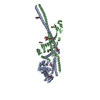
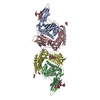
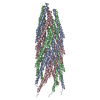




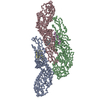
 PDBj
PDBj


